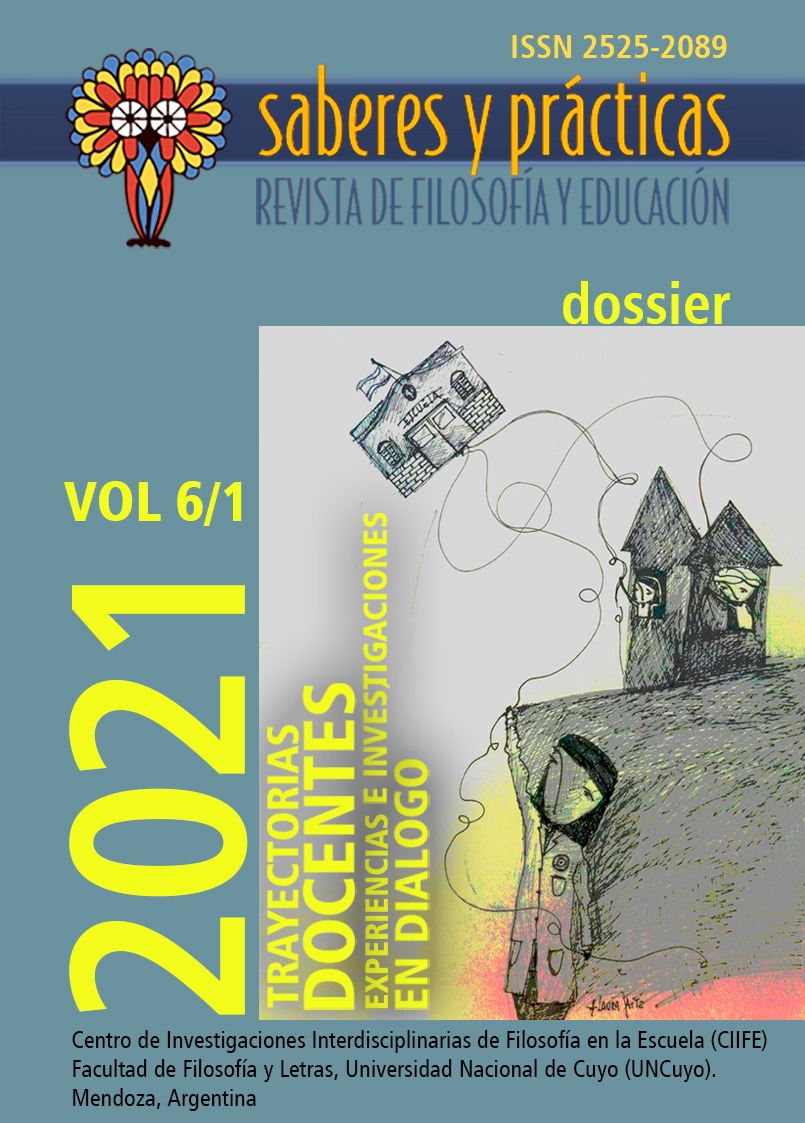Representation, recognition and meaning of the irrational number and the periodic function in the training of Secondary Education Teachers
DOI:
https://doi.org/10.48162/rev.36.023Keywords:
didactic phenomenon, irrational number, periodic function, ostensive mimicry, visual perceptionAbstract
This work studies a didactic phenomenon that can emerge in the construction of two mathematical notions, namely, irrational numbers and the periodic function (Reina and Wilhelmi, 2017; 2019). The semiotic conflicts associated with the visual recognition of numerical and functional periodicity are analyzed. It is observed that these conflicts can be grouped fundamentally in three dimensions: one, cognitive, relative to the form of acquisition of the notions by the subjects, especially in those aspects related to visual perception; another, epistemic, relative to the meaning attributed to mathematical objects, and, finally, teaching, relative to the rules of the didactic contract. The study provides a theoretical basis and provides empirical data on the difficulties associated with these three dimensions in the construction of the irrational number and the periodic function.
Downloads
References
Adamczewski, B. (2013). The Many Faces of the Kempner Number. Journal of Integer Sequences, 16, 1–34. http://adamczewski.perso.math.cnrs.fr/Kempner.pdf
Adamczewski,B. (2013). The Many Faces of the Kempner Number. Journal of Integer Sequences, 16, 1–34.http://adamczewski.perso.math.cnrs.fr/Kempner.pdf
Aragón, F., Bailey, D., Borwein, J. y Borwein, P. (2013). Walking on Real Numbers. The Mathematical Intelligencer, 35(1), 42–60.DOI 10.1007/s00283-012-9340-x
Brousseau, G. (2007). Iniciación al estudio de la teoría de las situaciones didácticas. Libros del Zorzal.
Buendía, G. y Montiel, G. (2009). Acercamiento socioepistemológico a la historia de las funciones trigonométricas. En P. Lestón (Ed.), Acta Latinoamericana de Matemática Educativa, 22, 1287-1288.CLAME. https://www.clame.org.mx/documentos/alme22.pdf
Collette, J.-P. (2007). Historia de las Matemáticas II. Siglo XXI.
Courant, R. y Jhon, F. (1999). Introducción al cálculo y al análisis matemático (Vol.I). Limusa.
Delahaye, J.-P.(2004). Les nombres zébrés. Pour la Science 321, 90-95. https://www.pourlascience.fr/sd/logique/les-nombres-zebres-3415.php#:~:text=%E2%80%93%20Il%20s'agit%20de%20nombres,de%20chiffres%20sans%20structure%20apparente.
Euler, L. (1748). Introducción al análisis de los infinitos (Tomo 1).SAEM Thales.
Font, V., Godino J. D.y D’Amore, B. (2007). An onto-semiotic approach to representations in mathematics education. For the Learning of Mathematics, 27(2), 2–7. http://www.ugr.es/~jgodino/funciones-semioticas/enfoque_ontosemiotico_representaciones.pdf
Godino, J., Batanero, C. y Font, V. (2009). The ontosemiotic approach to research in mathematics education. ZDM. The International Journal on Mathematics Education 39 (1-2), 127–135. http://enfoqueontosemiotico.ugr.es/documentos/JDGodino_CBatanero_VFont_sintesis_EOS%202009.pdf
Godino, J., Bencomo,D., Font,V. y Wilhelmi, M.R.(2006).Análisis y valoración de la idoneidad didáctica de procesos de estudio de las matemáticas. Paradigma,XXVII (2), 221-252. http://ve.scielo.org/scielo.php?script=sci_arttext&pid=S1011-22512006000200011
Godino, J, Cajaraville, J.A., Fernández, T. y Gonzato, M. (2012). Una aproximación ontosemiótica a la visualización en educación matemática. Enseñanza de las Ciencias, 30 (2) ,163-184. https://www.raco.cat/index.php/Ensenanza/article/view/254506/391053
Godino, J., Font, V., Wilhelmi, M.R. y De Castro, C.(2009). Aproximación a la dimensión normativa desde un enfoque ontosemiótico. Enseñanza de las Ciencias, 27(1), 59–76. https://www.raco.cat/index.php/Ensenanza/article/view/132207/0
Komatsu, T. (1999). On inhomogeneous diophantine approximation with some quasi-periodic expressions II. Journal de Théorie Des Nombres de Bordeaux, 11(2), 331–334. http://www.numdam.org/item?id=JTNB_1999__11_2_331_0
Larson,R., Hostetler, R. y Edwards,B.(1995). Cálculo y geometría analítica (5ta ed., Vol. 1.). McGraw-Hill.
Lopéz, C. A. (2014). El infinito en la historia de la matemática. Ciencia y Tecnología 14, 277-298. https://www.palermo.edu/ingenieria/pdf2014/14/CyT_14_18.pdf
Pickover, C. A. (2007). Las Matemáticas de Oz. RBA.
Reina, L. (2016).Simbiosis didáctica curricular entre el número irracional y la fracción continua en Educación Secundaria: restricciones, interacciones e idoneidad. [Tesis doctoral, Universidad Nacional de Cuyo]. http://enfoqueontosemiotico.ugr.es/tesis/Tesis_LReina.pdf
Reina, L. y Wilhelmi, M.R. (2017). Mimetismo ostensivo de objetos matemático. El caso de los números irracionales. En J. M. Contreras, P. Arteaga, G. R. Cañadas, M. M. Gea, B. Giacomone y M. M. LópezMartín (Eds.), Actas del Segundo Congreso International Virtual sobre el Enfoque Ontosemiótico del Conocimiento y la Instrucción Matemáticos. Universidad de Granada. https://digibug.ugr.es/handle/10481/45305
Reina, L. y Wilhelmi, M.R.(2019). Mimetismo ostensivo de objetos matemáticos. El caso de la función periódica en Formación de Profesorado. En K. Kapitango-A-Samba (Ed.), Residência e Desenvolvimento Profissional Docente (pp.305-333).CRV editora. https://editoracrv.com.br/produtos/detalhes/33747-residencia-e-desenvolvimento-profissional-docente
Reina, L. yWilhelmi, M.R. (en prensa). El problema didáctico del reconocimiento de los números irracionales en Educación Secundaria. IPN - Instituto Politécnico Nacional.
Reina, L., Wilhelmi, M.R. y Lasa, A. (2012). Configuraciones epistémicas asociadas al número irracional. Sentidos y desafíos en Educación Secundaria. Educación Matemática, 24(3), 67–97.http://www.redalyc.org/articulo.oa?id=40525846003
Reina, L., Wilhelmi, M.R., Carranza, P. y Lasa, A. (2014). Construcción de la noción de número irracional en formación de profesores: conflictos semióticos y desafíos. En P. Lestón (Ed.), Acta Latinoamericana de Matemática Educativa, 27, 629–637. CLAME. https://www.clame.org.mx/documentos/alme27.pdf
Rey Pastor, J., Pi Calleja, P. y Trejo, C. (1969). Análisis matemático (8ªed., Vol. 1.).Kapelusz.
Singh, S. (2011).Periodic functions. Openstax CNX. https://cnx.org/contents/ysm8oGY0@64.8:ECSl3qg_@8/Periodic-functions
Stupel, M. (2012). On periodicity of trigonometric functions and connections with elementary number theoretic ideas. Australian Senior Mathematics Journal, 26(1), 50-63. https://files.eric.ed.gov/fulltext/EJ992374.pdf
Thomas, G. y Finney, R. (1998). Cálculo. Una variable (9ed.). Adisson-Wesley-Longman.
Tóth, L. (2020). On Schizophrenic Patterns in b-ary Expansions of Some Irrational Numbers. Proceedings American Matemathical Society, 148,461-469. https://doi.org/10.1090/proc/14863
Downloads
Published
How to Cite
Issue
Section
License
License
This work is licensed under a Creative Commons Attribution-NonCommercial-ShareAlike 2.5 Argentina License.





















